- Author
- Clemens, Major W. F. M. MC.
- Subjects
- WWII operations
- Tags
-
- RAN Ships
- None noted.
- Publication
- September 1974 edition of the Naval Historical Review (all rights reserved)
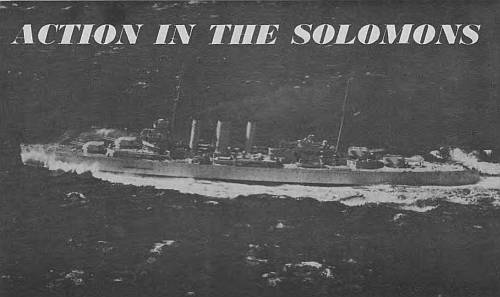
The text of this article consists of extracts from The Battle of Savo Island by Major W. F. M. Clemens, MC. Major Clemens viewed the battle from behind enemy positions on Guadalcanal where he was stationed as a Coastwatcher. The Solomons Battle was to be bitterly contested for almost two years and saw the might of the United States, Australia and Japan expended in a ruthless conflict.
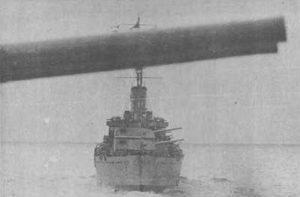
AFTER PEARL HARBOUR, the Japanese had no clear plan other than to extend the arc. Port Moresby was the objective in New Guinea, now to be assaulted from Buna by land, and a new Eighth Fleet, the Outer South Seas Force, was created out of Admiral Inoue’s Fourth Fleet on 12th July, with Headquarters at Rabaul. Command of this Force was given to Rear Admiral Gunichi Mikawa, a man of great experience who had followed Admiral Nagumo’s carriers from Ceylon to Pearl Harbour with supporting battleships. His orders were to protect the Solomon Islands flank. His operational staff officer – Commander Toshikazu Ohmae – had had a look around, and was disturbed at the complacency at Fourth Fleet Headquarters. However, in spite of local difficulties Admiral Mikawa hoisted his flag in Chokai, heavy cruiser, on 26th July. He was given Cru Div 6, four heavy cruisers Aoba, Kinugasa, Furutaka, and Kako, and two light cruisers, Cru Div 18, Tenryu and Vubari, and such destroyers as might be assigned. These continued in short supply owing to the landing operations on the New Guinea coast.

Japanese forces occupied the main islands of the Solomons on 8th June 1942 and commenced building airfields. The Allies reacted by massing a counterforce in New Zealand which assaulted Tulagi and Guadalcanal on 6th-8th August. Admiral Mikawa, based at Rabaul, gathered a striking force at New Britain which immediately sailed for Guadalcanal.
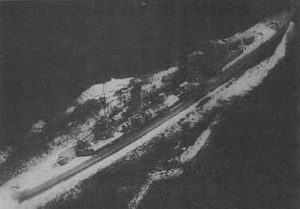
‘We will penetrate south of Savo Island and torpedo the enemy main force at Guadalcanal. Thence we will move toward the forward area at Tulagi and strike with torpedoes and gunfire, after which we will withdraw to the north of Savo Island.‘ The simplicity and audacity of this conception would have commended it to Horatio Nelson. In fact there were similarities to Nelson’s great action at Aboukir Bay. The Japanese ships had never operated together, but night battle doctrine was highly developed in the Japanese Navy, and Mikawa deemed no amplification of his orders necessary. As at Aboukir Bay, each knew how to co-operate with the other and follow the leader as the situation developed.
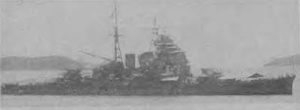
The silhouettes of Mikawa’s ships had caused derision amongst American sailors. Chokai, with one raked stack nearly meeting a slim one straight behind it, and a cluttered superstructure caused by her ten 8 in. guns in three turrets forward and two aft, 50 calibre weapons of high velocity, six AA guns of 4.7 inches, eight 25 mm and four 13 mm machine guns and eight deadly 24 in. torpedo tubes amidships, also had a triple and 3 in. to 4 in. armour along 410 feet of her sides, and 3 in. armour on her main deck and turrets. All in all a formidable ship. Aoba and Kinugasa, sisters, were finished in 1927, and Kako and Furutaka, also sisters, in 1926. They had twin stacks sharply raked, and six 8 in. guns in twin turrets, two forward and one aft, and, like Chokai, they had eight torpedo tubes amidships. They also had powerful 30 in. searchlights mounted with each group of turrets. These four comprised Cru Div 6 under R/Adm. Arimoto Goto. The Yubari and Tenryu, completed in 1923 and 1918 respectively, could still do 30 knots with their three screws.
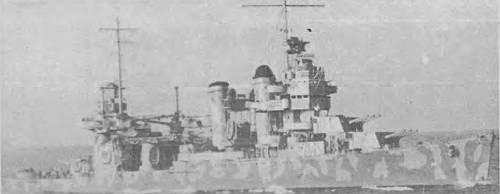
The Tenryu had three stacks, all different, while the Yubari had one odd structure with double bends in it. Yubari had six 5.5 in. guns, Tenryu four, and four and six torpedo tubes respectively.

They also had good searchlights fore and aft. The lone destroyer Yunagi, whose name funnily enough meant Evening Calm, was of 1925 vintage, but despite her age she could do 34 knots on four screws. She had four 4.7 in. guns and six torpedo tubes and, of course, two searchlights. The lighter vessels, Cru Div 18, were commanded by Rear Admiral Mitsuhara Maruyama. An odd lot, but no good came of laughing at them.
One need not be an expert naval tactician to observe that Admiral Crutchley had divided his force in such a way as to place each element in a position where it could be struck and annihilated separately. However, he had three channels to guard, and the only thing to do was to block them. However, they were in an ideal position to cross the ‘V’ of the Japanese invading force. All destroyers were equipped with torpedoes but no special orders about their use seem to have been issued. Torpedoes were to be Mikawa’s key weapon.
That the cruiser captains did not prepare seriously for the possibility of enemy surface attack (no orders were issued on this point and guns were all at different states of readiness) was amazing. Two thousand years ago SunTzu, the Chinese military philosopher, had warned ‘In war do not presume that the enemy will not come, prepare to meet him.‘

Our Southern group was on course 310° about 4 miles south of Savo, Canberra leading, Chicago 600 yards astern with Patterson and Bagley about 45° on port and starboard bows respectively. Canberra in second state of readiness had turrets A and X manned, although crews were sleeping close by. All guns were empty and trained fore and aft. One 4 in. was manned on each side. They were doing 12 knots. Blue outside Savo had been picked up at intervals on Canberra’s Type 271 surface warning radar; it had picked up cruisers at 30 miles, but not tonight. Chokai opened fire at 4,500 yards, Aoba at 5,000, and Furutaka at 9,000 with main batteries.





